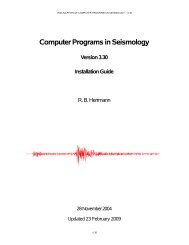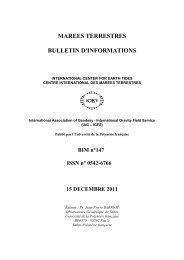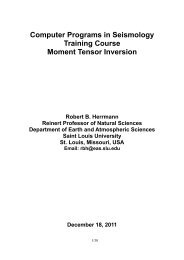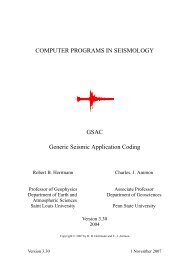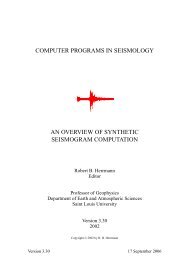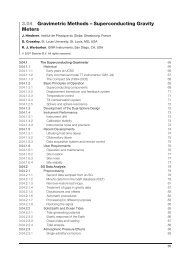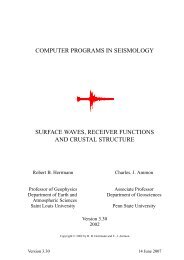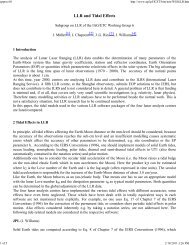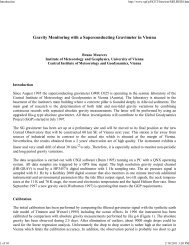11819 Superconducting Gravimeter OSG-050 at the Station Pecný ...
11819 Superconducting Gravimeter OSG-050 at the Station Pecný ...
11819 Superconducting Gravimeter OSG-050 at the Station Pecný ...
You also want an ePaper? Increase the reach of your titles
YUMPU automatically turns print PDFs into web optimized ePapers that Google loves.
<strong>Superconducting</strong> <strong>Gravimeter</strong> <strong>OSG</strong>-<strong>050</strong> <strong>at</strong> <strong>the</strong> St<strong>at</strong>ion <strong>Pecný</strong>, Czech Republic<br />
Vojtech Pálinkás, Jakub Kostelecký<br />
Research Institute of Geodesy, Topography and Cartography, Geodetic Observ<strong>at</strong>ory <strong>Pecný</strong>, CZ –<br />
251 65 Ondrejov 244, vojtech.palinkas@pecny.cz<br />
Abstract<br />
The <strong>Pecný</strong> st<strong>at</strong>ion is equipped by first-r<strong>at</strong>e instrument<strong>at</strong>ions in <strong>the</strong> field of terrestrial<br />
gravimetry thanks to <strong>the</strong> absolute gravimeter (AG) FG5#215 and superconducting gravimeter (SG)<br />
<strong>OSG</strong>-<strong>050</strong>. Repe<strong>at</strong>ed AG observ<strong>at</strong>ions <strong>at</strong> <strong>the</strong> <strong>Pecný</strong> st<strong>at</strong>ion allowed to determine <strong>the</strong> two important<br />
parameters of <strong>the</strong> SG, its scale and drift. The repe<strong>at</strong>ability of <strong>the</strong> FG5#215 has been also computed<br />
from combined time series.<br />
One year of SG observ<strong>at</strong>ions showed <strong>the</strong> sizeable improvement of earth tides observ<strong>at</strong>ions<br />
respect to <strong>the</strong> existing observ<strong>at</strong>ions with spring gravimeters and necessity to improve <strong>the</strong> method of<br />
air pressure effect correction by <strong>the</strong> single admittance. The noise of <strong>OSG</strong>-<strong>050</strong> in <strong>the</strong> normal mode<br />
band is higher than it would be expected. Small improvement of <strong>the</strong> noise characteristic was<br />
achieved by careful setting of dewar pressure.<br />
1. Introduction<br />
Continuous tidal observ<strong>at</strong>ions by spring gravimeters have been carried out <strong>at</strong> <strong>the</strong> st<strong>at</strong>ion<br />
<strong>Pecný</strong> since early seventies of <strong>the</strong> last century (Broz et al. 2005). Different type of spring<br />
gravimeters (Askania Gs11, Gs15, L&R, ZLS) has been used for observ<strong>at</strong>ions . Of course, during<br />
this long period, <strong>the</strong> gravimeters and registr<strong>at</strong>ion was dram<strong>at</strong>ically improved. Methods of<br />
calibr<strong>at</strong>ion, digital registr<strong>at</strong>ion, and feedback system development were milestones of observ<strong>at</strong>ion<br />
improvements (Brož et al., 2002; Pálinkáš, 2006). These improvements allowed to increase <strong>the</strong><br />
measurement accuracy more than 10 times during 30 years. The standard devi<strong>at</strong>ion of <strong>the</strong> observed<br />
hourly ordin<strong>at</strong>e on <strong>the</strong> level of 0.1 Gal was achieved which is comparable with older type of SGs<br />
(Ducarme et al., 2002). Unfortun<strong>at</strong>ely this high accuracy is relevant only for <strong>the</strong> short-period tides<br />
due to <strong>the</strong> instrumental drift. The drift of spring gravimeters <strong>at</strong> <strong>Pecný</strong> can be considered as linear for<br />
<strong>the</strong> period below one week in spite of <strong>the</strong> temper<strong>at</strong>ure and humidity control <strong>at</strong> <strong>the</strong> st<strong>at</strong>ion with<br />
precision of 0.1 o C and 1%, respectively.<br />
Fig. 1. The absolute gravimeter FG5#215 and <strong>the</strong> superconducting gravimeter <strong>OSG</strong>-<strong>050</strong> <strong>at</strong> <strong>the</strong> <strong>Pecný</strong> st<strong>at</strong>ion<br />
<strong>11819</strong>
The instrument<strong>at</strong>ion of <strong>the</strong> tidal st<strong>at</strong>ion has improved significantly thanks to <strong>the</strong><br />
superconducting gravimeter (SG) <strong>OSG</strong>-<strong>050</strong>, installed in February 2007. The <strong>Pecný</strong> st<strong>at</strong>ion as <strong>the</strong><br />
core st<strong>at</strong>ion of ECGN (European Combined Geodetic Network) is equipped with permanent GNSS<br />
st<strong>at</strong>ion, absolute gravimeter (AG) FG5#215 and <strong>the</strong> superconducting gravimeter <strong>OSG</strong>-<strong>050</strong>. These<br />
high quality instrument<strong>at</strong>ions in <strong>the</strong> field of gravimetry allow to monitor wide range of gravity<br />
vari<strong>at</strong>ions of geophysical origin from Earth’s free oscill<strong>at</strong>ions to secular gravity vari<strong>at</strong>ions.<br />
Possibility of frequent simultaneous AG and SG observ<strong>at</strong>ions <strong>at</strong> <strong>the</strong> st<strong>at</strong>ion allow to solve main<br />
problems of both instruments: drift and calibr<strong>at</strong>ion of <strong>the</strong> <strong>OSG</strong>-<strong>050</strong> and <strong>the</strong> offset vari<strong>at</strong>ions of <strong>the</strong><br />
FG5#215.<br />
2. Calibr<strong>at</strong>ion and drift<br />
The calibr<strong>at</strong>ion factor and drift of <strong>the</strong> SG has been determined using simultaneous<br />
observ<strong>at</strong>ions with <strong>the</strong> AG (Hinderer et al. 1998). Altoge<strong>the</strong>r 15, typically one-day absolute<br />
measurements with FG5#215 has been carried out from April 2007 to June 2008. For <strong>the</strong> purpose of<br />
SG calibr<strong>at</strong>ion, five AG campaigns has been extended to three-days observ<strong>at</strong>ions. These extended<br />
observ<strong>at</strong>ions were carried out during tidal vari<strong>at</strong>ions <strong>at</strong> least 230 Gal. The precision of all<br />
individual determin<strong>at</strong>ion of scale factor was better than 0.07%. However, <strong>the</strong> final calibr<strong>at</strong>ion factor<br />
and corresponding accuracy should be computed from results of repe<strong>at</strong>ed calibr<strong>at</strong>ions. The<br />
dispersion of individual results with corresponding error bars in Fig. 2 show necessity of such<br />
repe<strong>at</strong>ed measurements. The final calibr<strong>at</strong>ion factor of <strong>the</strong> <strong>OSG</strong>-<strong>050</strong> has been determined as average<br />
of all calibr<strong>at</strong>ions . From dispersion of individual result we can assume th<strong>at</strong> accuracy of <strong>the</strong> final<br />
calibr<strong>at</strong>ion factor is of about 0.06%.<br />
Fig. 2. Calibr<strong>at</strong>ion factor of <strong>the</strong> <strong>OSG</strong>-<strong>050</strong> determined from 5 simultaneous three-days observ<strong>at</strong>ions with<br />
FG5#215. Error bars represents precision of individual calibr<strong>at</strong>ions.<br />
The SG drift has been determined from <strong>the</strong> comparison between SG and AG observ<strong>at</strong>ions<br />
(see, Fig. 3 and Fig. 4) and described by linear term 1.7 0.4 Gal/year. We can assume, th<strong>at</strong> after<br />
removing drift from SG time-series, <strong>the</strong> rest of differences between AG and SG is caused mainly by<br />
random and system<strong>at</strong>ic errors of <strong>the</strong> AG. This approach can help to detect vari<strong>at</strong>ions in AG offsets.<br />
In our case (see, Fig. 4) all differences are within expected error bars of <strong>the</strong> AG (1.1 Gal, Niebauer<br />
et al. 1995). Comparison of both techniques has been used for <strong>the</strong> evalu<strong>at</strong>ion of FG5#215<br />
repe<strong>at</strong>ability (precision) by such experimental way. The standard devi<strong>at</strong>ion of individual absolute<br />
gravity measurements of 0.6 Gal respect to <strong>the</strong> <strong>OSG</strong>-50 observ<strong>at</strong>ions describe <strong>the</strong> precision of <strong>the</strong><br />
FG5#215. It is necessary to say th<strong>at</strong> <strong>the</strong> FG5#215 is not installed permanently <strong>at</strong> <strong>the</strong> <strong>Pecný</strong> st<strong>at</strong>ion<br />
and <strong>the</strong> precision of 0.6 Gal includes error of instrumental set-up, meter alignments etc.<br />
11820
Fig. 3. Gravity series of <strong>the</strong> FG5#215 and <strong>OSG</strong>-<strong>050</strong>, corrected for earth tides, air pressure vari<strong>at</strong>ions by<br />
single admittance and effect of polar motion.<br />
3. Time delay<br />
Fig. 4. Differences between gravity series for determin<strong>at</strong>ion of SG drift and AG repe<strong>at</strong>ability.<br />
The time delay of <strong>the</strong> <strong>OSG</strong>-<strong>050</strong> in tidal frequency band was evalu<strong>at</strong>ed from <strong>the</strong> transfer<br />
function of <strong>the</strong> meter, experimentally determined by injection step voltage into <strong>the</strong> feedback (Van<br />
Camp et al. 2000). Altoge<strong>the</strong>r 34 injections have been carried out for three different size of steps<br />
(15V, 10V and 5V). For <strong>the</strong> processing <strong>the</strong> TSOFT (Vauterin and Van Camp, 2001) and ETSTEP<br />
(Wenzel, 1995) software were used. Both processing method and also three-different size of steps<br />
gave results within 0.03 sec (see, Tab. 1). Specially <strong>the</strong> results from ETSTEP software show high<br />
consistency and precision. Utiliz<strong>at</strong>ion of ETSTEP seems to be more efficient but it need careful and<br />
correct evalu<strong>at</strong>ion of initial and final step values. On <strong>the</strong> o<strong>the</strong>r hand <strong>the</strong> method using TSOFT is<br />
more user-friendly.<br />
Table 1. Time delay of <strong>the</strong> <strong>OSG</strong>-<strong>050</strong> for three different size of steps (15V, 10V and 5V) and computed with<br />
two different software (TSOFT and ETSTEP), - time delay, n - number of steps<br />
TSOFT ETSTEP<br />
(n) [sec] (n) [sec]<br />
15 Volt 8.873 0.012 (10) 8.856 0.003 (4)<br />
10 Volt 8.860 0.010 (10) 8.853 0.005 (4)<br />
5 Volt 8.884 0.019 (14) 8.853 0.021 (4)<br />
Average 8.868 0.009 8.855 0.002<br />
11821
4. Tidal analysis<br />
The tidal analysis was carried out by <strong>the</strong> program ETERNA 3.4 (Wenzel, 1996) for <strong>the</strong><br />
period April 2007 – June 2008. The tidal parameters of main tidal waves determined from <strong>the</strong> <strong>OSG</strong>-<br />
<strong>050</strong> record show <strong>the</strong> agreement better than 0.05% in amplitude and 0.04 deg in phase with results of<br />
spring gravimeters during last 6 years. The very good agreement in amplitude demonstr<strong>at</strong>es <strong>the</strong><br />
accur<strong>at</strong>e calibr<strong>at</strong>ion of gravimeters by simultaneous measurements with FG5#215 (Pálinkás, 2006),<br />
when <strong>the</strong> spring meters and <strong>OSG</strong>-<strong>050</strong> have been calibr<strong>at</strong>ed over 60 and 15 days, respectively.<br />
Table 2. Comparison of <strong>the</strong> results of tidal measurements with Askania, LaCoste & Romberg and<br />
superconducting gravimeter <strong>at</strong> <strong>the</strong> st<strong>at</strong>ion <strong>Pecný</strong>. The results were computed by ETERNA 3.4 (Wenzel,<br />
1996), - amplitude factor, - phase lag [deg].<br />
<strong>Gravimeter</strong> ASKANIA Gs15 #228<br />
electromag. feedback<br />
Period<br />
Days<br />
2000 04 – 2005 04<br />
1568<br />
L&R G #137<br />
MVR feedback<br />
2002 09 – 2004 04<br />
522<br />
11822<br />
<strong>OSG</strong>-<strong>050</strong><br />
2007 04 – 2008 06<br />
435<br />
Wave <br />
O1<br />
K1<br />
M2<br />
S2<br />
1.1503<br />
1<br />
1.1373<br />
1<br />
1.1851<br />
1<br />
1.1804<br />
1<br />
0.122<br />
0.004<br />
0.185<br />
0.003<br />
1.229<br />
0.003<br />
0.018<br />
0.007<br />
1.1500<br />
1<br />
1.1370<br />
1<br />
1.1846<br />
1<br />
1.1820<br />
1<br />
0.102<br />
0.004<br />
0.155<br />
0.003<br />
1.209<br />
0.003<br />
0.104<br />
0.006<br />
1.1505<br />
1<br />
1.1374<br />
1<br />
1.1856<br />
1<br />
1.1826<br />
1<br />
[nms -2 ] 1.61 0.63 0.59<br />
0.122<br />
0.004<br />
0.196<br />
0.003<br />
1.240<br />
0.002<br />
0.156<br />
0.005<br />
The air pressure correction has been applied as component of <strong>the</strong> tidal analysis by ETERNA<br />
using regression coefficient with local air pressure. The regression coefficient of -3.3 nm s -2 /hPa as<br />
result of tidal analysis doesn’t describe air pressure correction sufficiently due to frequency<br />
dependence of single admittance. This situ<strong>at</strong>ion can be seen in Fig. 5 and confirm <strong>the</strong> necessity to<br />
improve <strong>the</strong> existing method of air pressure effect correction using single admittance.<br />
Implement<strong>at</strong>ion of corrections based on <strong>the</strong> 3D <strong>at</strong>mospheric models (Neumeyer et al., 2004) and local<br />
air pressure observ<strong>at</strong>ions is necessary.<br />
Fig. 5. Frequency dependence of <strong>the</strong> air pressure admittance
5. Noise in normal mode band<br />
The <strong>Pecný</strong> st<strong>at</strong>ion is loc<strong>at</strong>ed in a quiet place, far away from industrial noise and <strong>the</strong> SG pillar<br />
is founded on <strong>the</strong> quartzite bedrock. It should be expected, th<strong>at</strong> noise in normal mode band<br />
(0.2 mHz – 10 mHz) will be low and thus <strong>the</strong> conditions for monitoring Earth’s free oscill<strong>at</strong>ions<br />
excellent. Unfortun<strong>at</strong>ely, <strong>the</strong> comparison of power spectral densities with New Low Noise Model<br />
(NLNM, Peterson 1993) in Fig. 6 shows sizeable noise in this frequency band. The seismic noise<br />
magnitude(SNM, Banka and Crossley, 1999) of <strong>the</strong> <strong>OSG</strong>-<strong>050</strong> is of about 1.4. To achieve best noise<br />
characteristic of <strong>the</strong> <strong>OSG</strong>-<strong>050</strong>, <strong>the</strong> influence of <strong>the</strong> dewar pressure setting has been experimentally<br />
studied by comparison of power spectrums under different pressure condition. Improvement less<br />
than 5 dB has been achieved by sensitive setting of <strong>the</strong> dewar pressure (see, Fig. 6).<br />
Fig. 6. Power spectral densities of <strong>the</strong> <strong>OSG</strong>-<strong>050</strong> in normal mode band for different dewar pressures<br />
6. Conclusions<br />
During <strong>the</strong> first year of observ<strong>at</strong>ion with <strong>the</strong> <strong>OSG</strong>-<strong>050</strong> <strong>at</strong> <strong>Pecný</strong> <strong>the</strong> main parameters and<br />
characteristics of <strong>the</strong> meter has been determined. Calibr<strong>at</strong>ion coefficient and <strong>the</strong> time delay were<br />
estim<strong>at</strong>ed with <strong>the</strong> accuracy of 0.06% and 0.01 sec, respectively. The comparison of SG and AG<br />
observ<strong>at</strong>ions helped to determine <strong>the</strong> SG linear drift of 1.7 0.4 Gal/year and <strong>the</strong> FG5#215<br />
repe<strong>at</strong>ability of 0.6 Gal. The analysis of recorded d<strong>at</strong>a showed <strong>the</strong> very good properties of <strong>the</strong><br />
meter for monitoring gravity vari<strong>at</strong>ions below 0.1 mHz (earth tides, hydrological effects etc.). On<br />
<strong>the</strong> o<strong>the</strong>r hand <strong>the</strong> observ<strong>at</strong>ions in normal mode band (0.2 mHz – 10 mHz) are affected by sizeable<br />
noise of instrumental origin.<br />
The superconducting gravimeter <strong>OSG</strong>-<strong>050</strong> <strong>at</strong> <strong>the</strong> st<strong>at</strong>ion <strong>Pecný</strong> represents dignified<br />
continu<strong>at</strong>ion of earth tide observ<strong>at</strong>ion started in early seventies of <strong>the</strong> last century. Thanks to <strong>the</strong><br />
good drift characteristics of <strong>the</strong> meter and regular repe<strong>at</strong>ed absolute gravity measurements, <strong>the</strong>re is<br />
a good chance to determine valuable parameters of long-period tides and to monitor gravity<br />
vari<strong>at</strong>ions of hydrologic and geodynamic origin. Moreover, <strong>the</strong> <strong>OSG</strong>-<strong>050</strong> seems to be very<br />
important instrument for absolute gravimeter FG5#215 (n<strong>at</strong>ional standard for acceler<strong>at</strong>ion due to<br />
gravity) to monitor vari<strong>at</strong>ions of its system<strong>at</strong>ic errors and consequently improve accuracy and<br />
credibility of our absolute measurements.<br />
11823
References<br />
Banka, D., Crossley, D. (1999). Noise levels of superconducting gravimeters <strong>at</strong> seismic frequencies.<br />
Geophys. J. Int. 139, 87– 445.<br />
Broz, J., Simon Z., Pálinkás V. (2005). The Gravimetric Tidal St<strong>at</strong>ion <strong>Pecný</strong>. 50 years of <strong>the</strong> RIGTC, Jubilee<br />
Proceedings 1994-2004, Zdiby, pp. 121-130.<br />
Broz, J., Z. Simon, J. Dupac, A. Zeman. (2002). Two Feedback Systems to <strong>the</strong> Gs15 No.228 <strong>Gravimeter</strong>.<br />
Marees Terrestres Bulletin d'Inform<strong>at</strong>ions. No. 137, pp. 10937-10951.<br />
Ducarme, B., He-Ping Sun, Jian-Qiao Xu, (2002). New Investig<strong>at</strong>ion of Tidal Gravity Results from <strong>the</strong> GGP<br />
Network. Marees Terrestres Bulletin d'Inform<strong>at</strong>ions. No. 136, pp. 10761-10776.<br />
Hinderer, J., M. Amalvict, N. Florsch, O. Francis, J. Mäkinen. (1998). On <strong>the</strong> Calibr<strong>at</strong>ion of<br />
<strong>Superconducting</strong> <strong>Gravimeter</strong>s with <strong>the</strong> Help of Absolute Gravity Measurements. Proceedings of <strong>the</strong> 13th<br />
Intern<strong>at</strong>ional Symposium on Earth Tides, Brussels, July 1997. Obs. Royal Belgique, Brussels, pp. 557-564.<br />
Neumeyer, J., J. Hagedorn, J. Leitloff, T. Schmidt. (2004). Gravity reduction with three-dimensional<br />
<strong>at</strong>mospheric pressure d<strong>at</strong>a for precise ground gravity measurements. Journal of Geodynamics, Volume 38,<br />
Issues 3-5, pp. 437-450.<br />
Niebauer, T., G. S. Sasagawa, J.E. Faller, R. Hilt, F. Klopping. (1995). A New Gener<strong>at</strong>ion of Absolute<br />
<strong>Gravimeter</strong>s. Metrologia, 32, pp. 159-180.<br />
Pálinkás, V. (2006). Precise Tidal Measurements by Spring <strong>Gravimeter</strong>s <strong>at</strong> <strong>the</strong> St<strong>at</strong>ion <strong>Pecný</strong>. Journal of<br />
Geodynamics, Volume 41, Issues 1-3, 2006, pp. 14-22.<br />
Peterson, J., 1993. Observ<strong>at</strong>ions and Modelling of Seismic Background Noise. Open-File Report 93U.S.<br />
Department of Interior, Geological Survey, Albuquerque, New Mexico.<br />
Vauterin, P., Van Camp, M. (2001). Tsoft Manual.<br />
Van Camp, M., Wenzel, H.-G., Schott, P., Vauterin, P. and Francis, O. (2000).Accur<strong>at</strong>e transfer function<br />
determin<strong>at</strong>ion for superconducting gravimeters. Geophys. Res. Let., 27, 1, 37-40.<br />
Wenzel, H.G. (1995). Accur<strong>at</strong>e instrumental phase lag determin<strong>at</strong>ion for feedback gravimeters. Proc. 12 th Int.<br />
Symp. Earth Tides, 191-198, H.T. Hsu (ed.), Science Press, Beijing, New-York.<br />
Wenzel H. G. (1996). The Nanogal Software: Earth Tide D<strong>at</strong>a Processing Package: ETERNA 3.3. Marees<br />
Terrestres Bulletin d'Inform<strong>at</strong>ions. No. 124, pp. 9425-9439.<br />
11824




